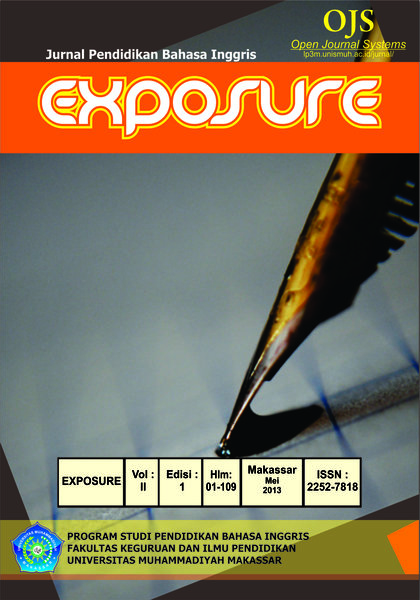IMPROVING THE STUDENTS’ READING COMPREHENSION USING TIERED TASKS STRATEGY
DOI:
https://doi.org/10.26618/exposure.v2i1.784Abstrak
This research aimed to explain the students’ achievement in literal reading comprehension using Tiered Tasks Strategy, as well as to explain the students’ achievement in interpretative reading comprehension using Tiered Tasks Strategy. This research used Classroom Action Research and applied to cycles in the application, they are cycle 1 and 2 with 4 meetings in every cycle. The improvement of students’ ability to write narrative text using Tiered Tasks Strategy had an effective effect. The researcher found that before the application of tiered tasks strategy the students’ score is 52.53(fair) but after using the method the students’ score in cycle I is 62.14 and in the cycle, II become 77.18. So, the improvement of the students’ score of d-test to cycle I is 18.93% whereas the development of the students’ ability of d-test to cycle II is 47.80% and the improvement from cycle I to cycle II is 24.22%.
Keywords: Reading, Tiered, Strategy
Referensi
Billerica, N, 2005. Building Levels of Comprehension: Multiple Choice and Short- Respons Reading Questions, New Jersey. Curriculum Assosiation, Inc.
Cooper, J. D. 1984. Improving Reading Comprehension. Boston Houghton Mifflin Company.
Depdikbud 1985. Petunjuk Pelaksanaan Proses Belajar Mengajar dan Petunjuk Pelaksanaan Penilaian. Jakarta : Departemen Pendidikan dan Kebudayaan.
Gay, L. R. 1981. Education research: Competences For Analysis and Application (second edition), Columbus, Onion: Charles E Mevil Publishing Company.
Hahn, Karla. April 2005. Tiered princing: implication for library collection, http://hdl.handle.net/1903/7080,27 july
Harmer, Jeremy.1998. How to Teach English. Pearson logman. England
Harris, A. Josiah and Edward R. S, 1980 How to Increase Reading Ability
Journal A tree-tiered team model for undergraduate preceptor programs (zerbe, Melissa B. DNSc, RN; LACHAT, MARYANNE F.PhD,RN)
National Middle School Association. 4151 Executive Parkway Suite 300,
Westerville, OH 43081. Tel: 800-528-6672; Tel: 614-895-4730; Fax: 614-895-4750; e-mail: info@nmsa.org; Web site:
http://www.nmsa.org/Publications/tabid/95/Default.aspx
Robinson, Alam, H. 1998. Teaching Reading and Strategy. Library of Congress cataloging in publication data
Scaffolding & Tiered Teaching Methods | eHow.com http://www.ehow.com/way_5452723_scaffolding-tiered-teaching-methods.html#ixzz21h3ZEsdg
Taylor, B., Harris, L,. A & Person, P D. 1986. Reading Difficulties: instruction and Assesment’ Random House; New York.
Unduhan
Diterbitkan
Terbitan
Bagian
Lisensi
Authors who publish with this journal agree to the following terms:
In order to assure the highest standards for published articles, a peer review policy is applied. In pursue of the compliance with academic standards, all parties involved in the publishing process (the authors, the editors and the editorial board and the reviewers) agree to meet the responsibilities stated below in accordance to the Journal publication ethics and malpractice statement.
Duties of Authors:
- The author(s) warrant that the submitted article is an original work, which has not been previously published, and that they have obtained an agreement from any co-author(s) prior to the manuscript’s submission;
- The author(s) should not submit articles describing essentially the same research to more than one journal;
- The authors(s) make certain that the manuscript meets the terms of the Manuscript Submission Guideline regarding appropriate academic citation and that no copyright infringement occurs;
- The authors(s) should inform the editors about any conflict of interests and report any errors they subsequently, discover in their manuscript.
Duties of Editors and the Editorial Board:
- The editors, together with the editorial board, are responsible for deciding upon the publication or rejection of the submitted manuscripts based only on their originality, significance, and relevance to the domains of the journal;
- The editors evaluate the manuscripts compliance with academic criteria, the domains of the journal and the guidelines;
- The editors must at all times respect the confidentiality of any information pertaining to the submitted manuscripts;
- The editors assign the review of each manuscript to two reviewers chosen according to their domains of expertise. The editors must take into account any conflict of interest reported by the authors and the reviewers.
- The editors must ensure that the comments and recommendations of the reviewers are sent to the author(s) in due time and that the manuscripts are returned to the editors, who take the final decision to publish them or not.
Authors are permitted and encouraged to post online a pre-publication manuscript (but not the Publisher’s final formatted PDF version of the Work) in institutional repositories or on their Websites prior to and during the submission process, as it can lead to productive exchanges, as well as earlier and greater citation of published work (see The Effect of Open Access). Any such posting made before acceptance and publication of the Work shall be updated upon publication to include a reference to the Publisher-assigned DOI (Digital Object Identifier) and a link to the online abstract for the final published Work in the Journal.

